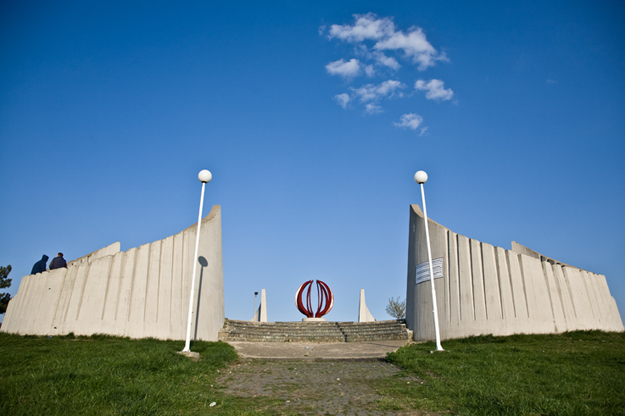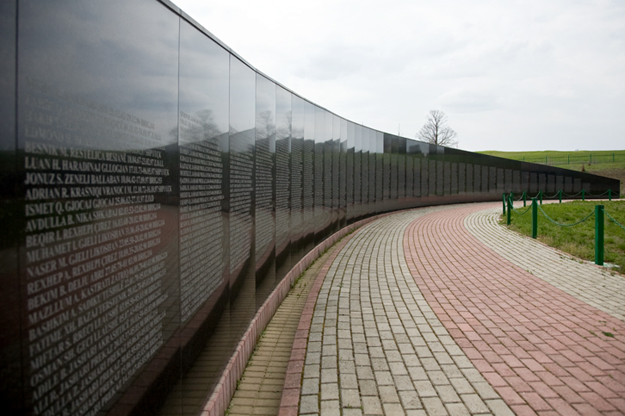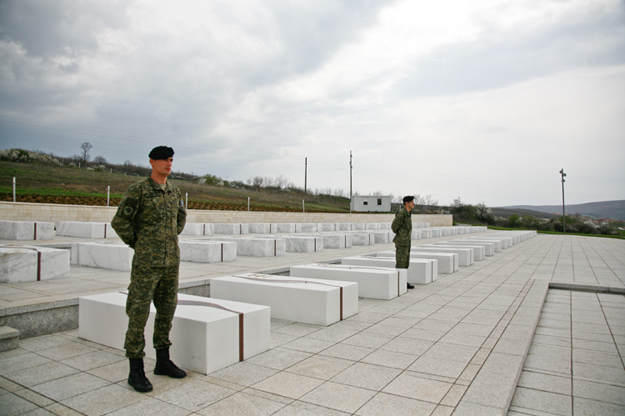When I was a child, I often walked across Piazzetta Nove Martiri (The Nine Martyrs’ Square) in my native L’Aquila, a town in central Italy. As a good Catholic girl, I imagined the nine martyrs as Christians fed to the lions by pagan emperors. I never looked at the plaque commemorating the young men ages 17 to 21 who joined the resistance in September 1943 but were immediately captured by Nazis, forced to dig their own graves, and shot. I continued to be unaware of that plaque later, during the many after-school hours spent in the square, a favorite meeting point for students.
Austrian writer Robert Musil wrote that memorials are present everywhere but are invisible. I understood what that meant when I realized why the commemorative plaque of the nine martyrs was overlooked. In my conservative town, the Catholic Church and the prewar elites who returned to power in 1945 had minimized the history of the local resistance – too closely identified with the left for comfort – and suppressed the memory of its dead; kids executed before they could fire a shot were easy to forget and so was their cause. This taught me that heroes are more easily remembered; that the memory of the war dead is connected to how a collective identifies itself; and that there is a struggle over their memory, which is also a struggle for power.
Since summer 1999, I have been documenting the many Kosovo Liberation Army (KLA) memorials: plaques, tombstones, statues, monuments, burial grounds and at least one pilgrimage destination of national significance. I photographed these war memorials at different times, suspecting that although most of them were made of stone, one day they could become invisible like the National Martyrs Monument in Velania, once an imposing reminder of Yugoslav partisans who died in World War II, it stands now as a prop for children’s games. The history of these more recent KLA monuments provides a unique field to understand how Kosovo’s dead were “buried” in competing identifications of the Albanian nation. In fact, criticisms of war memorials quickly appeared as counter stories to the KLA’s official one of heroic resistance.

The National Martyrs monument in Velania as a testament to the Yugoslav partisans who died in World War II.
General Fabio Mini, the commander of NATO-led Kosovo Force in 2002 and 2003, thought that by building monuments KLA’s veterans intended to obfuscate their criminal responsibilities both in war and in peacetime, as he put it in the book “La guerra dopo la guerra” (The War after the War). General Mini seized the role of families and survivors in commemorating their dead as self-serving, a ploy, in his words, to distract the public from the terrorist and criminal activities of former freedom fighters. He expressed what many foreign soldiers and bureaucrats living in Kosovo also thought, but could never publicly say: that independence from Serbia had feet of clay.
In a much different context, I have heard many Kosovars criticize the proliferation and the purpose of war memorials, questioning the heroism of the KLA. These critics largely belong to prewar elites and groups that never agreed with the armed rebellion against Milosevic, choosing instead the path of constitutional reform and legal continuity; this strategic choice was symbolically tied to self-identification with an image of European modernity. They saw the KLA – a guerrilla group that never was a proper army, but a network of rural families, friends and fellow travelers, a liminal community that ignored existing hierarchies – as a rebellion against their authority and their world. In postwar Kosovo, these groups resent the hold on power obtained by politicians legitimized by the KLA. It is in their interest to downplay the memory of the war.

The Gllogjan memorial, built by former KLA commander Ramush Haradinaj, incorporates a stone kulla, a connection between the country and its rural heritage.
It is true that at first the commemoration of fallen KLA fighters was left to families and survivors (there was no state), who elaborated their private grief by turning it into a public discourse on the liberation war. Yet, there is nothing conspiratorial or unique in this practice, common to Europe since World War I, when even the smallest village built a monument to its dead in that war. Then, as now, families, veteran groups and local communities were the main agents of memory, before the state took this task upon itself. Post-World War II Yugoslavia is a different story: then, war memorials were an integral part of a program of top-down state-building. A case in point is the monument to the putative “brotherhood and unity” forged during the partisan resistance that crowned the refashioning of the old Ottoman center of Prishtina into a modernist urban space.
French historian Antoine Prost wrote that all war memorials embody a complicated system of meanings: to concentrate on one aspect of it, or on the possible hidden motivations of those who build them, is likely to mislead. The symbolism of Kosovo’s war memorials can be found in the written messages they carry, their physical structure, the time of their construction, and their location. One is a common trait: they celebrate the Albanian nation by using the whole repertoire of the patriotic imagination based on ethnic belonging. Theirs is an ethno-nation, and that’s why the struggle over their significance is about authenticity.
In the immediate aftermath of the war, the memorials dotting Kosovo’s landscape were mostly a simple tombstone with the KLA logo, a name and dates of birth and death. Some included the hyper-realistic engraving of a uniformed and armed young man, but most were quite bare. Many of these funerary monuments were private efforts, and it shows. Their first objective was to memorialize a father, a son, a brother or a husband. More than one hundred women died, but they are hardly featured in memorials. Self-aggrandizers, said the critics, made a graveyard of Kosovo for their own benefit.

The KLA memorial, similar to the Vietnam War memorial in Washington D.C., stands on the road from Drenas to Skenderaj.
Later, monuments became more elaborate, often dedicated to more than one person. They were shaped as stylized double-headed eagles or outsize “plis;” a few added constructions imitating the “kulla.” They all commemorated fighters whose common virtues – courage, honor, self-sacrifice – are based on traditionalist culture. The attention shifted from the individual to an allegoric, traditionalist representation of the national collective. At the Gllogjan’s memorial, built under the sponsorship of KLA leader Ramush Haradinaj, a fully reconstructed “ kulla” stands next to the heroes graveyard: The nation thus represented as authentically steeped in the rural world is an object of celebration as much as the men who died for it. Too much folklore, said the same domestic critics who complained about the proliferation of monuments: We are a modern, European nation. Too much Albanian-ness, said foreign critics such as the international experts on transitional justice focused on promoting reconciliation. It alienates Serbs living in Kosovo.
In more recent years, war cemeteries have sprung up, amid disputes. Veterans’ associations maintain these cemeteries should be dedicated to the KLA, the “deshmoret e kombit” (martyrs of the nation). By dying in combat, they are martyrs in the original sense of “witnesses to the cause” (here, the nation), as in Christian and Islamic theologies. In the case of the Landovica cemetery, to name one, veterans’ associations disagreed with the Prizren municipality over the exclusion of the KLA logo and symbolic blood streams on the design of tombstones. Without those signs, the dead would be only “ martir,” the Albanian word that denotes noncombatant victims. Politically alien to the KLA, the municipality claimed institutional authority to redefine the war dead, trying to expunge the KLA from the record.
What has struck me over the years is that whatever the political disagreement over their aesthetic or symbolic meanings, Kosovo’s war memorials are fundamentally sites of mourning. For this reason, they will remain visible for a long time. On the road from Drenas to Skenderaj, a KLA memorial stands as a replica of the Vietnam War Memorial in Washington, D.C., the product of a private fundraising drive in the United States. As in D.C., the engravings of the names in the dark granite wall allow survivors to “touch” their dead. The ritual of touching a photo, a name or a stone, says Yale University historian Jay Winter, keeps the living connected with the dead and is almost universal in its power to assuage the pain of loss.

Soldiers guard graves at the Prekaz memorial. Though politicians occasionally try to politicize the site of the Jashari family massacre, surviving relatives serve as reminders that it is a sacred ground.
The promise of victory over death is crucial to the elaboration of mourning. Many inscriptions have a transcendental tone, such as the ubiquitous, “Glory to the martyrs of the nation.” They mention eternal life, as in the randomly chosen individual tombstones: “Fallen to never die” (Rasim Kiçina and Ragip Halilaj, Durdica); “Fallen here to win immortality” (Sejdi F. Shala, on the road from Skenderaj to Klina). At the Prekaz Memorial Complex, the life-size portrait of the most prominent war hero, Adem Jashari, appears under the caption, “He is Alive.” The book memorializing about 1,700 fallen KLA fighters, a “text-monument” to the war, calls the dead “phoenixes,” the mythical figures that live forever. Their message also is meant to live forever. Memorials are prominently placed at the center of towns, in squares and along the main roads, because they need visibility to remind what the nation owes its dead, as in the random dedications: “The blood of martyrs lays at the foundation of freedom” (Manush Berisha on the road from Prizren to Gjakova); “Dead so we can live in freedom” (Shaqir Hoxha, in Nekovce, Drenica); “Your heroism and your courage made Kosova free” (Naser Ahmet Kodra, Polac). This is memory projected into the future.
The Jashari Memorial in Prekaz is the best example of the complexity and changeability of Kosovo’s war memorials. The main reminder of the KLA legacy (amanet) to fight and die for the nation, now, as a state park, it also includes a “field of peace,” extolling a national tradition of reconciliation. Because of its importance, politicians make frequent pilgrimages to this site, often using it as a background to foster their causes. They sometimes forget it is also a site of mourning, but the survivors will not. Murat Jashari must periodically remind various political actors that the memorial is not up for grabs to serve specific interests, not only because it is a national shrine, but because it stands on hallowed ground, a “campo santo”: his grandparents, mother, brothers and sisters, uncle, aunt and cousins are buried there.

